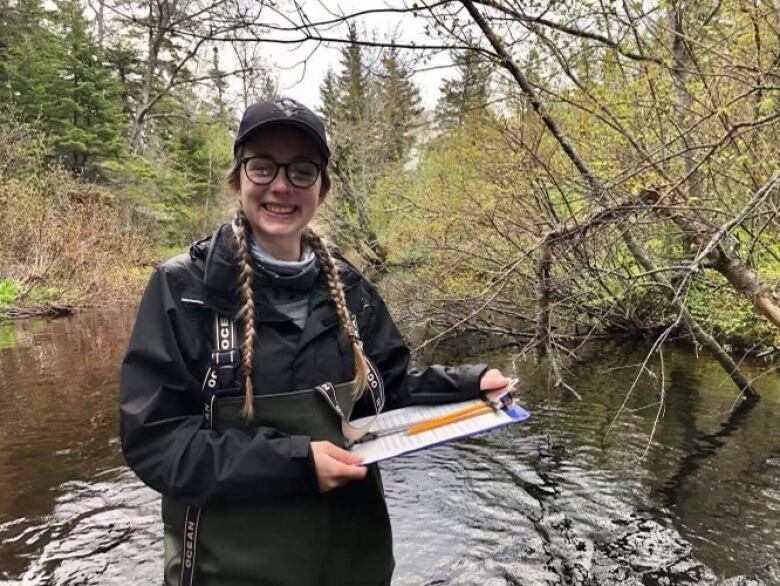A Nova Scotia group of volunteers goes out on warm, rainy nights in April to help dozens of salamanders cross roads and get to their breeding grounds without being harmed by vehicles.
If you’re exploring one of Nova Scotia’s many wooded areas on a rainy night in April and see a group of people with flashlights and high-visibility gear on the side of the road, there’s a good chance they’re staking out a salamander crossing.
Yellow-spotted salamanders are the province’s largest species of salamander. They spend most of their lives underground, but surface for about two weeks every spring to breed.
It’s easy to predict where these salamanders will cross to get to their breeding pools – they live for about 30 years and use the same pathways for their entire lives.
But the crossings can be risky, so they need a little help.
“You can just imagine how much things have changed over a 30 year period, especially in urban areas,” said Clarence Stevens, an environmental consultant involved in several local and provincial volunteer conservation efforts.
“Many of these salamanders have to cross roads or even multiple roads to reach their breeding grounds now. As a result of that, a lot of them end up being run over.”
That’s where Stevens and his group of volunteers come in.
They go out on nights with perfect conditions and look for large groups of salamanders near the road. Then they help them across.
“On the warm, rainy nights we’re able to help, like, 40 or 50 or over 100 of them … because they’re making a mass movement at that time,” Stevens said.
Stevens and other nature enthusiasts have been monitoring salamander crossings for years. But he partnered last year with the non-profit Halifax Field Naturalists to encourage people across the province to go out on their own to help with crossings.
Laura Eamon is one of the volunteers who started working with the group last year. She had never even seen a salamander before she heard of Stevens’s campaign, but she was hooked after the first night.
“It’s just something that you can do, it’s a couple of hours, it’s immediate, and you can really see the impact with the habitat improvement,” Eamon said.
She said her most rewarding experience was digging ditches on the side of a trail to allow salamanders a place to safely lay their eggs.
The next day, the ditch was lined with hundreds of eggs.
“So the amphibians were able to see the new location and lay their eggs there,” Eamon said. “And it didn’t exist before we went out. So it was just the most incredible feeling.”
Species in ‘rapid decline’
Yellow-spotted salamanders are not classified as endangered or at-risk, but Stevens said their numbers are in “rapid decline” like many other species of amphibians.
“Amphibians are very sensitive to changes in their environment,” he said.
“So any time a water body becomes polluted or you get runoff from the road or anything like that, and even changing temperatures, are killing them off.”
He said the survival rate of the species’ eggs is also low. The spotted salamander lays eggs in water, but the location must meet certain conditions.
“They can’t use any pools or ponds or lakes big enough to have fish in them because the fish gobble up their eggs like crazy,” Stevens said. This means they often lay eggs in puddles, which isn’t ideal.
Because of this, ATVs are a large risk for salamander populations, Eamon said.
“You know, the most fun part of being on an ATV is going through puddles, but those puddles are perfect pools for amphibians to lay their eggs.”
She said the volunteers try to seek out eggs on trails and move them off to the side to give them a better chance of reaching maturity.
When salamanders disappear from an area, Stevens said it has a large impact.
“They play such an important role in our environment, that as they disappear from bodies of water, those bodies of water become more infested with insects. And there’s a whole cascade effect.”
What to do if you spot one
Anyone out for a rainy April walk can help a salamander if they stumble upon one. Stevens said he has some simple tips for would-be rescuers.
If you’re moving them off the road “take them in the direction that they’re facing even if you don’t see water because they may be leaving the water because they’ve already laid their eggs and heading back to the forest again.”
Stevens said clean hands are a must to handle salamanders.
Eamon said she takes her stepdaughters out with her to look for amphibians. She suggested anyone who is interested can learn how.
“Clarence is a salamander connoisseur and is able to … look over maps of your community with you and find spots that might be potential active zones for amphibians,” she said.






